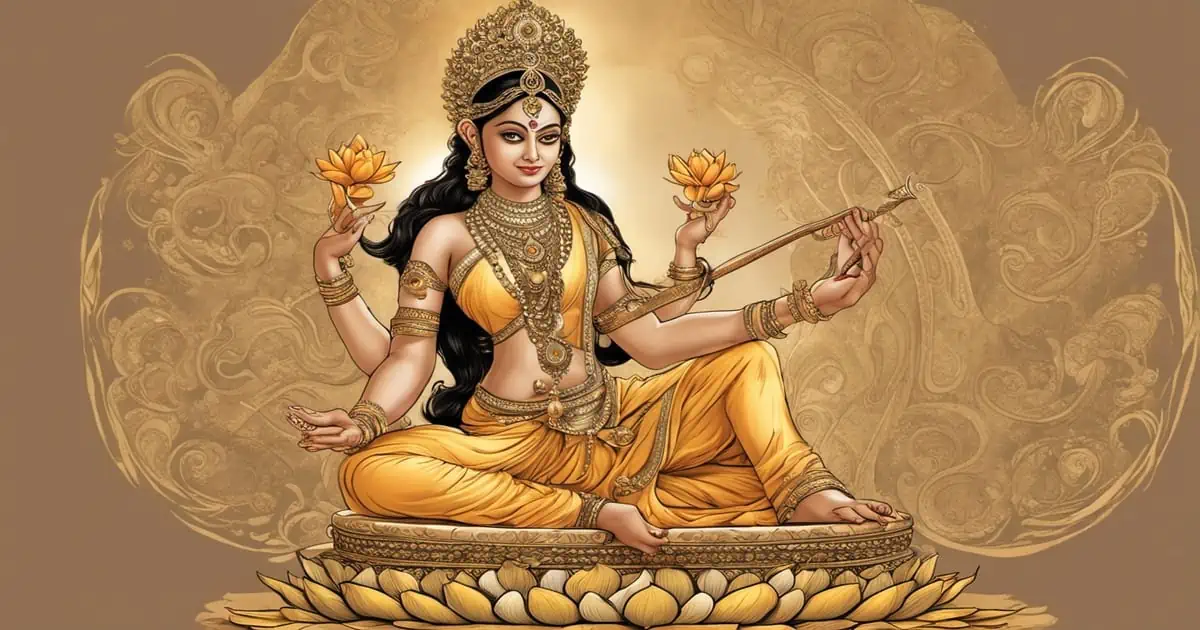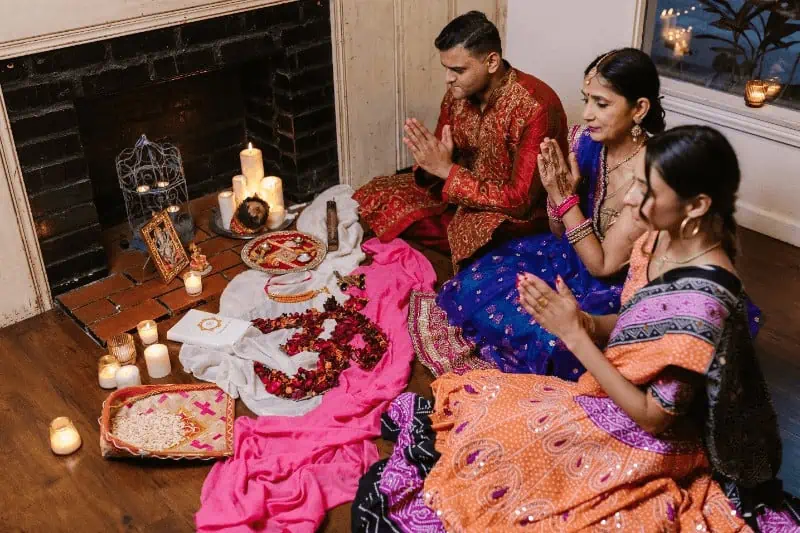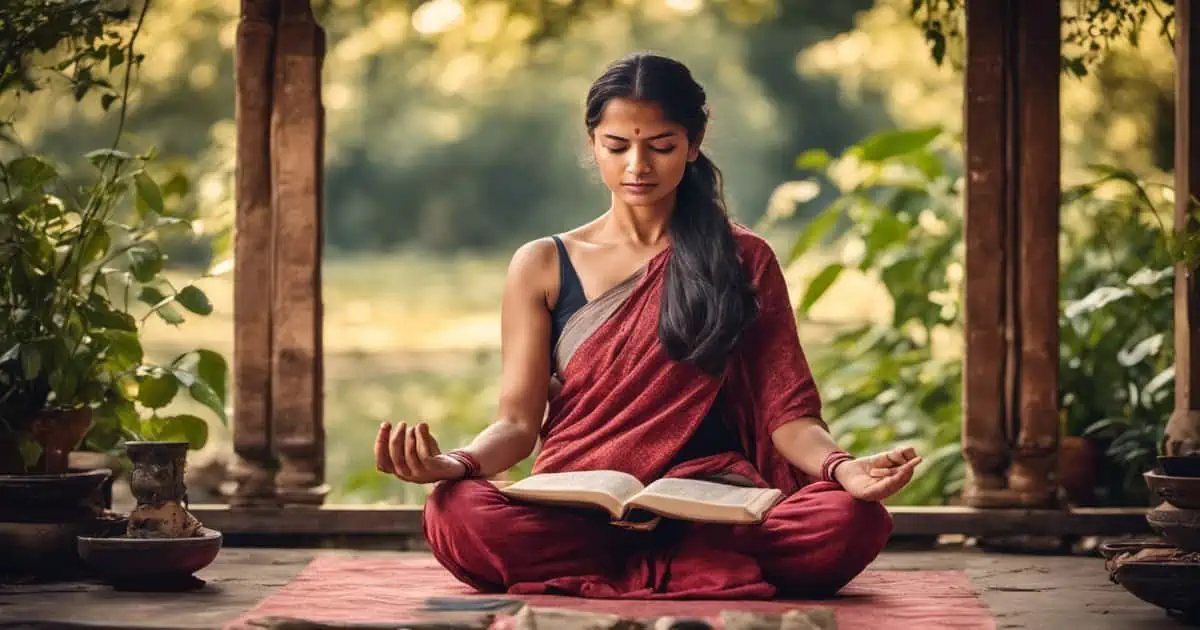At the end of a yoga class, we often place our palms together and chant “Aum,” creating a powerful transformative vibration. Mantras are like little keys that unlock the doors to different spiritual realms. One of the most potent mantras is the Gayatri Mantra, an ancient verse with profound meaning.
Some mantras are pretty simple and easier to pick up on. For someone new to the practice of mantra chanting, this 24-syllable mantra may seem intimidating at first glance, with many unfamiliar Sanskrit words. But with a bit of guidance and practice, you, too, can experience the positive forces of this universal prayer.
Read on as we take a friendly, step-by-step approach to unravel the beauty and significance of the Gayatri mantra. We’ll break it down into easy-to-learn terms, making this ancient wisdom accessible to all curious souls.
Contents
Overall Meaning and Significance
The Gayatri Mantra is part of a hymn found in the Rig Veda, an ancient Hindu text. It embodies spiritual light and holds universal appeal as it asks for blessings for the well-being of all living beings.
This mantra is more than a prayer; it invokes Savitur (or Savitr), the sun deity who represents spiritual light, divine knowledge, and the source of all creation. For this reason, you might also hear it called the Sāvitri Mantra.
The essence of this mantra transcends religious boundaries and aids those who meditate on it to connect with their prana or life force. Its historical significance and profound meaning make it an integral part of Hinduism and a beacon for those seeking spiritual enlightenment.
Translation and Interpretation
The original purpose of this chant was to invoke divine light and spiritual knowledge. It’s like asking the sun, a symbol of literal and spiritual light, to guide us from darkness to true knowledge.
Om Bhur Bhuvah Swaha, Tat Savitur Varenyam, Bhargo Devasya Dhimahi, Dhiyo Yo Nah Prachodayat”: This verse’s meaning translates roughly to “We meditate on the divine light of the Sun deity, who inspires our intellect and spiritual awakening.”

An obvious connection to nature is one of the defining characteristics of this mantra. The sun symbolizes divine light guiding us through life’s journey. It also represents our life force or prana — an element vital for our existence.
Another unique aspect of this sacred chant is that it connects the value of personal growth to the universal welfare of all living beings. Those who seek spiritual enlightenment may use this mantra to awaken their intuition and deepen their understanding of life.
This concise yet potent prayer contains the essence of spiritual seeking, devotion, and pursuing higher knowledge and truth.
Gayatri (Sāvitri) Mantra’s Ancient Origins
The origin of this ancient prayer is the Sanskrit text, the Rig Veda. It’s one of the oldest known scriptures in human history, written between 1500 and 1200 B.C.E.
This scripture is a collection of more than ten thousand mantras and is divided into ten sections called Mandala. The Gayatri Mantra occurs in the third Mandala of the text, hymn number 62, verse 10.
The mantra invokes the life-giving power of the solar deity but is also associated with the goddess Gayatri, known as the divine mother.
A Divine Story
Later texts, such as the Ramayana and Bhagavad Purna, include a legend about how this transformational prayer came to be recorded. The story goes like this:
A king named Vishwamitra, with hopes of becoming a spiritual master, went seeking knowledge and power. He encountered a sage, Vasistha, who tested the king’s intentions by creating obstacles with his divine cow, Nandini.
After many failed attempts and recognizing the limitations of his power, King Vishwamitra experienced a change of heart and expressed humility. This transformation finally pleased Vasistha. In return, the sage bestowed the Gayatri mantra to Vashwamitra.
In the end, receiving the wisdom of the mantra transformed Vishwamitra into a revered sage, illustrating the importance of humility and the transformative power of the Gayatri mantra.
Who is Gayatri?

As Hinduism developed over thousands of years, the mantra evolved as well. What began as a meditation explicitly centered on a solar deity has expanded to be more of a universal prayer.
Although the words in this ancient hymn specifically mention the solar deity Savitur (hence its alternate name, the Sāvitri mantra), it is personified by the Goddess Gayatri, who gives this iconic mantra its more commonly used name.
Gayatri is a form of divine feminine energy often called the Divine Mother. As a deity, she represents the nurturing and protective aspects of the divine and is a fount of spiritual wisdom. She is typically depicted with five heads, symbolizing the five elements of the universe.
Devotees of Gayatri invoke her name in meditation and prayer to receive guidance and spiritual enlightenment.
Role in Hindu Culture and Beyond

Use in Hindu Rituals and Ceremonies
The continued widespread use of this mantra is lasting proof of its powers. It is still chanted during rituals and Hindu ceremonies on significant occasions and as an everyday prayer. Some of its uses include:
- Sandhyavandanam, a daily ritual performed by Hindu priests
- Upanayana or Thread Ceremony, a rite of passage ceremony for young boys
- Funeral and ancestor rituals
- Special occasions such as festivals or marriages
- Yajnas and Homas, fire rituals and offerings
- Daily meditation or japa (repetition) practice
- Deity worship to bless temples and home shrines
Influence on Indian Arts
The Gayatri Mantra transcends religious practices. It has influenced classical Indian music and dance forms with its rhythm and vibration.
- Classical musicians often incorporate the mantra into their compositions.
- Bharatanatyam, a classical Indian dance form, sometimes includes movements that express the essence of the Gayatri Mantra.
- Cultural festivals use the mantra in song and dance to celebrate special occasions.
Depiction in Popular Culture
Surprisingly, this ancient prayer shows up in unexpected places. You can find references to it in films, books, art – you name it!
- Countless Bollywood movies have used renditions of this mantra.
- Indian musical artist Deva Premal and pop icon Cher have sung this mantra to large audiences all over the world!
- A version of the Gayatri mantra is included in the soundtrack for the popular science fiction show Battlestar Galactica.
Proper Chanting Guide and Analysis
This particular Mantra is more than just a string of words or a lyrical verse; it’s part of a spiritual practice. To deepen your understanding of the mantra, let’s first translate the meanings of each word.
Word by Word Translation
- Om: Represents the sound of the universe and the source of all creation
- Bhur: Physical body or existence.
- Bhuvah: Consciousness and the energetic body.
- Swah: Spiritual realm or the soul
- Tat: That
- Savitur: The Sun God, Savitar
- Varenyam: Most excellent, worthy of adoration
- Bhargo: Divine light, effulgence, or radiance
- Devasya: Of the deity
- Dheemahi: To focus the mind or meditate
- Dhiyo: Intellect or understanding
- Yo: Who
- Nah: Our
- Prachodayat: May inspire or guide
Structure of the Mantra
The next step is to begin putting the mantra together in phrases. Let’s examine its three main parts.
- Invocation: “Om Bhur Bhuvah Swah.” The opening phrase of the mantra offers praise to the divine and acknowledges the different realms of existence.
- Meditation: “Tat Savitur Varenyam Bhargo Devasya Dheemahi.” This second section is the core meditation, focusing on the solar deity, associated with knowledge and enlightenment and who is the source of all life.
- Prayer: “Dhiyo Yo Nah Prachodayat.” The closing phrase is a prayer asking for the divine to inspire clarity of thought and understanding.
Pronunciation Guide for Each Syllable
Finally, let’s put the whole mantra together! The phonetic pronunciation of each line is in parentheses.
Om Bhur Bhuvah Swah (Aum Bhoor Bhoo-va Su-va-ha)
Tat Savitur Varenyam (Taht Sa-vee-toor Var-ayn-yum)
Bhargo Devasya Dheemahi (Bar-go Day-vas-ya Dhee-ma-hee)
Dhiyo Yo Nah Prachodayat (Dhee-yo Yo Nah Pra-cho-da-yaat)
Rhythm or Meter Used (Gayatri Meter)
The Gayatri Mantra follows a specific rhythm known as the Gayatri meter, composed of 24 syllables divided into three lines of eight syllables each. The precise arrangement of syllables and the meter create a specific resonant vibration.
A note on symbolism: dividing the verse into three phrases is symbolic of the Hindu trinity or Trimurti: Brahma (the creator), Vishnu (the preserver), and Shiva (the destroyer).
Everything about these syllables is entirely intentional. The symbolism in just a few short lines becomes increasingly profound asg you examine it.
Ideal Time and Other Chanting Instructions

The traditional instructions for chanting the Gayatri Mantra are based on Vedic traditions passed down through generations. These instructions can be found in ancient texts like the Rig Veda.
Following the ancient rituals of chanting will provide the most positive effects. Here are the recommendations per Vedic scripture.
- Proper pronunciation: The carefully selected syllables hold powerful vibrational forces when chanted, so strive for correct pronunciation in your recitation of the Gayatri. Follow along with the pronunciation guide above, or listen to a recording as you’re learning the Sanskrit words.
- Time of day: Early morning and evening (between 4 and 8 a.m. and p.m.) is the best time, as these are highly spiritually charged times of day.
- Number of repetitions: While there isn’t a specified number for repetition, most mantras cycle for 108 rounds. If that number seems a bit daunting in the beginning, aim for 36. The secret formula is to use a multiple of 3, an auspicious number in Hinduism.
- Direction: If possible, face toward the east in the morning and to the west in the evening, following the path of the sun as it rises and sets.
- Posture: Your body should be comfortable and relaxed, with your back as straight as possible. You may sit on a yoga mat, blanket, or against a wall for extra support.
- Right Intention: Hold the intention of sincerity, devotion, and humility in your heart to openly accept the divine spiritual light.
Benefits and Impact on Life
When chanted regularly, the Gayatri mantra profoundly impacts the chanter’s life. Its positive effects range from promoting emotional stability to enhancing cognitive abilities.
- Inner Peace and Stress Management: When chanted daily, the Gayatri mantra helps people manage stress better. The specific sound vibrations promote peace, regulate the heart rate, calm the mind, and reduce anxiety.
- Better Concentration and Cognitive Abilities: Practicing this mantra can significantly enhance concentration. The repetition of the syllables allows the mind to focus entirely on a single task, improving cognitive abilities over time.
- Overall Well-being: In general, a daily mantra-based meditation practice inspires positive lifestyle changes to benefit your physical body, mental health, and spiritual development. With consistent practice over time, you may notice significant improvements in your quality of life.
Scientific Research Findings
Don’t believe us? Check out the scientific proof that backs the powers of the Gayatri mantra!
- A group of athletes who chanted the Gayatri mantra daily showed improved attention, memory, mental state, and anxiety levels.
- Another study among Indian schoolchildren indicated that using the mantra before a task improved attention and performance.
- A review of several scientific studies offers proof that mantra-based meditation can reduce stress, hypertension, and anxiety levels and even boost immunity!
Getting Started
So, now you’re ready to experience the powers of this magical mantra for yourself! Here are some helpful tools and resources that will help you master it in no time.
- Check out this short video to hear clear pronunciation and meter.
- Listen to this hour-long recording with 108 repetitions.
- Read more about the hidden power of daily chanting with books like this one.
- Keep your body comfortable by purchasing a meditation cushion like this one from Alo Yoga.
- Keep a set of Mala beads in your hand to count your repetitions.
Remember, there is no secret formula for a perfect practice — take all the tips and inspiration you’ve learned here, and make the mantra your own!

The Universal Prayer
The universality of the Gayatri (Sāvitri) Mantra is a testament to its profound spiritual significance. It transcends religious boundaries and has a universal appeal due to its inherent power and the positive energy it brings to those who chant it with devotion.
This mantra serves as a guiding light, illuminating our path toward spiritual enlightenment and inner peace. People can experience numerous benefits that positively impact their lives through proper chanting and understanding of the Gayatri Mantra.
But don’t just take our word for it — start your journey of personal growth and inner peace today! Clear your mind, take a deep breath, and feel the resonating forces of Gayatri within you as you sing this ancient, universal prayer.
Commit to a daily routine, and see how your life transforms!
FAQ 1: What is the correct way to chant the Gayatri Mantra?
The correct way to recite the Gayatri involves clear pronunciation of each syllable while maintaining a steady rhythm. Sit in a peaceful environment with your eyes closed during chanting to enhance focus.
FAQ 2: How does chanting this specific mantra benefit my life?
Chanting the Gayatri (or Sāvitri) mantra aids in achieving mental clarity, reducing stress levels, increasing concentration abilities, fostering positivity, and enhancing self-awareness, among other benefits.
FAQ 3: Is this mantra appropriate for non-Hindus?
Absolutely! The power of this mantra is accessible to people from any background. Anyone can experience its benefits if their hearts are set on the right intention.
FAQ 4: How often should I chant the Gayatri Mantra?
Aim for once per day to get the best results from chanting this mantra, with a minimum of three repetitions. However, you can choose a frequency that suits your lifestyle and comfort.


